Table of Contents
CBSE Sample Papers for Class 12 Economics Outside Delhi – 2015
Time allowed : 3 hours Maximum marks 100
GENERAL INSTRUCTIONS
(i) All questions in both the sections are compulsory.
(ii) Marks for questions are indicated against each.
(iii) Questions No. 1-5 and 17-21 are very short-answer questions carrying 1 nick each. They are required to be answered in one sentence each.
(iv) Questions No. 6-10 and 22-26 are? short-answer questions carrying 3 marks each. Answers to them should normally not exceed 60 words each.
(v) Questions No. 11-13 and 27-29 are also short-answer questions carrying 4 marks each. Answers to them should normally not exceed 70 words each.
(vi) Questions No. 14-16 and 30-32 are long-answers questions carrying 6 marks each. Answers to them should normally not exceed 100 words each.
(vii) Answers should be brief and to the point and the above word limit should be adhered to as far as possible.
SET I
SECTION A
Question.1. Define indifference curve.
Answer. Indifference curve refers to the graphical representation of various alternative combinations of bundles of two goods among which the consumer is indifferent.
Question.2. If due to fall in the price of good X, demand for good Y rises, the two goods are: (choose the correct alternative)
(a) Substitutes (b) Complements (c) Not related (d) Competitive
Answer. (b) Complements
Question. 3. If Marginal Rate of Substitution is increasing throughout, the Indifference Curve will be: (choose the correct alternative)
(a) Downward sloping convex (b) Downward sloping concave
(c) Downward sloping straight line (d) Upward sloping convex
Answer. (b) Downward sloping concave
Question. 4. Giving reason comment on the shape of Production Possibilities Curve based on the following schedule:
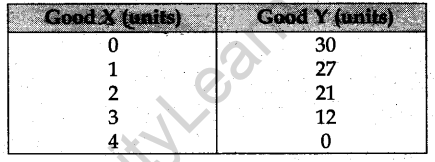
Answer. Marginal rate of transformation (MRT) is the ratio of number of units of a commodity sacrificed to gain an additional unit of another commodity.
\(MRT=\frac { \Delta \quad in\quad units\quad sacrificed }{ \Delta \quad in\quad units\quad gained } \)
It represents the slope of PPF. As can be seen from the given schedule, MRT is increasing, i.e., more and more units of Y have to be sacrificed for a unit increase in production of X.The PPC would be concave to the origin.

Question.5. What is likely to be the impact of “Make in India” appeal to the foreign investors by the Prime Minister of India, on the production possibilities frontier of India? Explain.
Answer. The Prime Minister of India has appealed to the people the world over to come and make in India and sell their products in any country of the world. This initiative is expected to focus on job creation and skill enhancement in various sectors.
The Prime Minister has appealed to the foreign investors to make investments in various sectors and boost the ‘Make in India’ initiative with the much needed infrastructure and rapid urbanisation. The inflow of foreign resources will increase the country’s available resources and boost the country’s developmental process thereby shifting the Production Possibility Frontier (PPF) upwards to the right signifying increase in its productive capacity.
Or
What is likely to be the impact of efforts towards reducing unemployment on the production potential of the economy? Explain.
Answer. Reducing unemployment has no effect on the production potential of the economy because production potential is determined assuming full employment. If the government makes efforts towards reducing unemployment by starting employment generating schemes, since the amount of resources has not changed and only the existing resources are being optimally utilized, therefore the economy would move from below potential production towards or on optimum production potential. This means that the PPF would not be affected but that the economy would move from a production combination inside the PPF to a production combination nearer or on the PPF.
Question.6. Explain the significance of ‘minus sign’ attached to the measure of price elasticity of demand in case of a normal good, as compared to the ‘plus sign’ attached to the measure of price elasticity of supply.
Answer. See Q. 6, 2015 (I Delhi).
Question.7. In a perfectly competitive market the buyers treat products of all the firms as homogeneous. Explain the significance of this feature.
Answer. Homogeneous product means identical in all respects like shape, size, quality etc. The buyers in a perfectly competitive market, treat the products of all firm as homogeneous, they do not differentiate between products of different firms.They are willing to pay only the same price for the products of all the firms. It also implies that no individual firm is in a position to charge a higher price for its product. This ensures uniform price in the market.
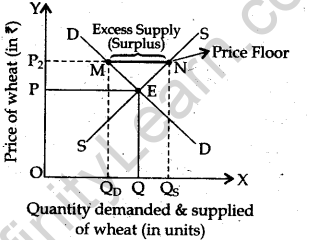
Question.8. What are the effects of ‘price-floor’ (minimum price ceiling) on the market of a good?Use diagram.
Answer. Price floor refers to the minimum price (above the equilibrium price), fixed by the government, which the producers must be paid for their produce. When the government feels that the price fixed by the forces of demand and supply is not remunerative from the producer’s point of view, then it fixes a price (know as price floor) which is more than the equilibrium price, e.g., agricultural price support programs and minimum wage legislation.
The effect of price floor can be better understood with the help of the given diagram.As shown in the diagram, equilibrium is determined at point E and equilibrium price at OP.Suppose to protect the producer’s interest, government declares OP2 as the minimum price (price floor) which is more than the equilibrium price. At this price producers are willing to supply OQs while consumers demand only OQD, there is surplus in the market equal to MN. This excess supply may be purchased by the government either to create buffer stocks or for exports or producers may try to illegally sell below the minimum price.
Note: The following question is for the blind candidates only in lieu of Q. No. 8,
Explain the effects of ‘price-floor’ (minimum price ceiling) on the market of a good.
Answer. When government imposes a lower limit on a price that may be charged by the producers of a good or service, it is called price floor.
Since this price is above the equilibrium price, at this price producers-are willing to supply more but the buyers are willing to buy less. This creates surplus in the market. Due to this producers may adopt illegal ways and sell the product or service at a lower price.
Question.9. A consumer spends Rs 1000 on a good priced at Rs 10 per unit. When its price falls by 20 percent, the consumer spends Rs 800 on the good. Calculate the price elasticity of demand by the Percentage method.
Answer.

Question.10. What is the behavior of (a) Average Fixed Cost and (b) Average Variable Cost as more and more units of a good are produced?
Answer.
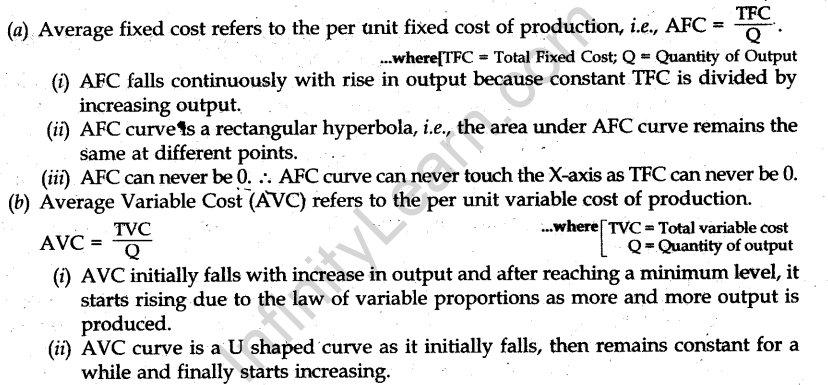
Or
Define Average Revenue . Show that Average Revenue and Price are same.
Answer.

Question.11. A consumer consumes only two goods X and Y, both priced at Rs 2 per unit. If the consumer chooses a combination of these two goods with Marginal Rate of Substitution equal to 2, is the consumer in equilibrium? Why or why not? What will a rational consumer do in this situation? Explain.
Answer.

Or
A consumer consumes only two goods X and Y whose prices are Rs 5 and Rs 4 respectively. If the consumer chooses a combination of the two goods with marginal utility of X equal to 4 and that of Y equal to 5, is the consumer in equilibrium? Why or why not? What will a rational consumer do in this situation? Use utility analysis.
Answer. In utility analysis, the two necessary conditions to attain consumer’s equilibrium in case of two commodities are:
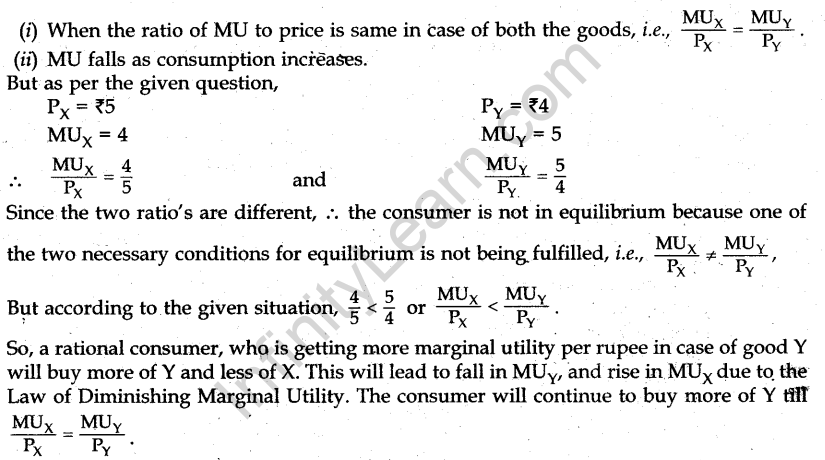
Question.12. What are the different phases in the Law of Variable Proportions in terms of marginal product? Give reason behind each phase. Use diagram.
Answer. Law of Variable Proportions states that as we increase quantity of only one input keeping other inputs fixed, MP initially increases then falls and becomes zero and finally becomes negative. The behavior of output can be explained with the help of the given diagram. Phase I. Increasing returns to a factor. In the first phase, variable input is too small as compared to the fixed factor so every additional variable factor adds more and more to the total product leading to increase in MP. This is due to better utilization of fixed factor and improved efficiency of variable factor due to specialization. This phase continues till point Q on the diagram.
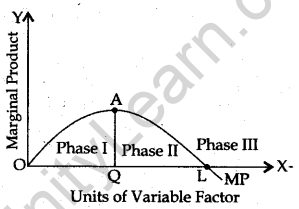
Phase II. Diminishing returns to a factor. In the second phase, every additional variable factor adds lesser and lesser amount of output leading to decrease in MP. This happens because after making optimum use of fixed factor, the marginal return or productivity of variable factor begins to diminish. Also there is a limit to the extent of which one factor of production can be substituted for another. This phase continues till point L on the diagram. MP starts falling but remains positive.
Phase III. Negative returns to a factor. In this phase, the employment of additional variable factor causes TP to decline and MP becomes negative. This happens because the amount of variable factor becomes too large in comparison to the fixed factor. Excess of variable factor leads to poor co-ordination between fixed and variable factors. As a result total output falls instead of rising and marginal product becomes negative. Also with increase in variable factor, the advantages of specialization and division of labour start diminishing resulting in inefficiencies of variable factor.
Note: The following question is for the blind candidates in lieu of Q. No. 12 only.
Explain with the help of a numerical example different phases in the Law of Variable Proportions.
Answer. See Q. 12, 2015 (I Delhi).
Question.13. Explain why will a producer not be in equilibrium if the conditions of equilibrium are not met.
Answer. Producer’s equilibrium refers to that price and output combination which brings maximum profit to the producer and profit declines as more is produced. According to MR-MC approach, producer’s equilibrium will be achieved when, (i) MC = MR and (ii) MC > MR after MC = MR output level. Both the conditions are needed to achieve equilibrium.
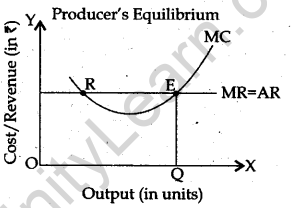
(i) MC = MR. Every producer aims to maximise the total profits. For this, a firm compares its MR with its MC. Profits will increase as long as MR exceeds MC. So, equilibrium cannot be achieved when MC < MR as it is still possible to earn profits by increasing production. Producer would also not like to produce when MC>MR because this implies that benefit is less than cost, i.e., the firm will be in equilibrium only when MC=MR.
(ii) MC > MR after MC = MR output level. This condition also has to be fulfilled because MC=MR may occur at more than one output level. But equilibrium output level will be the one after which MC becomes greater than MR because then it will not be possible to earn any profit.
As shown in the diagram, producer’s equilibrium will be determined at OQ level of output corresponding to point E because it is only at this point that both the conditions of equilibrium are met.
Question.14. Market for a good is in equilibrium. The supply of good “decreases”. Explain the chain of effects of this change.
Answer. See Q. 15, 2014 (III Delhi).
SECTION B
Question.15. What is ‘aggregate demand’ in macroeconomics?
Answer. Aggregate demand refers to the total value of final goods and services which all the sectors of an economy are planning to buy at a given level of income during a period of one accounting year.
Question.16. If MFC = 1, the value of multiplier is: (choose the correct alternative)
(a) 0 (b) 1 (c) Between 0 and 1 (d) Infinity
Answer. (d) Infinity
Question.17. Primary deficit in a government budget is: (choose the correct alternative)
(a) Revenue expenditure – Revenue receipts (b) Total expenditure – Total receipts
(c) Revenue deficit – Interest payments (d) Fiscal deficit – Interest payments
Answer. (d) Fiscal deficit – Interest payments
Question.18. Direct tax is called direct because it is collected directly from: (choose the correct alternative)
(a) The producers on goods produced (b) The sellers on good sold
(c) The buyers of goods (d) The income earners
Answer. (d) The income earners
Question.19. Other things remaining the same, when in a country the market price of foreign currency falls, national income is likely: (choose the correct alternative)
(a) to rise (&) to fall .
(c) to rise or to fall (d) to remain unaffected
Answer. (b) to fall
Question.20. If the Real GDP is Rs 400 and Nominal GDP is Rs 450, calculate the Price Index (base = 100).
Answer.

Question.21. What are fixed and flexible exchange rates?
Answer. Fixed exchange rate refers to a system in which exchange rate for a currency is fixed by the government/central bank and is not influenced by the demand and supply of foreign exchange. The basic purpose of adopting this system is to ensure stability in foreign trade and capital movements.
Flexible exchange rate refers to a system in which exchange rate is determined by forces of demand and supply of different currencies in the foreign exchange market. There is no official (government) intervention in the foreign exchange market. It is also known as floating exchange rate.
Or
Explain the meaning of Managed Floating Exchange Rate.
Answer. Managed floating exchange rate refers to a system in which foreign exchange rate is determined by market forces and central bank influences the exchange rate through intervention in the foreign exchange market. It is a hybrid of fixed exchange rate and flexible exchange rate system. In this system, central bank intervenes in the foreign exchange market to restrict the fluctuations in the exchange rate within certain limits. When foreign exchange rate is too high, the central bank starts selling foreign currency from its reserves. When it is too low central bank starts buying foreign currency. The aim is to keep the exchange rate close to the desired target values. It is also known as ‘dirty floating’.
Question.22. Where is ‘borrowings from abroad’ recorded in the Balance of Payments Accounts? Give reasons.
Answer. “Borrowings from abroad” will be recorded in the ‘capital account’ of BOP account because it increases international liability of the country.
Capital account of BOP account records international transactions which affect foreign assets and foreign liabilities of domestic country with rest of the world. Transactions relating to borrowings from abroad by private sector, government etc. are recorded on the credit side of capital account. It is recorded on the credit side because it leads to inflow of – foreign exchange in the country.
Question.23. Explain the “Bankers’ Bank function” of the central bank.
Answer. Being the apex bank, the Central Bank acts as the banker to other banks, i.e., it has the same relationship with commercial banks as the latter maintains with the general public.
As the banker to banks, the Central Bank functions in three capacities:
(i) Custodian of Cash reserves. Commercial banks are required to keep a certain percentage of their cash reserves (known as cash reserve ratio or CRR) with the Central Bank.
(ii) Lender of the last resort When commercial banks fail to meet their financial requirements from other sources, they approach the Central Bank to give loans and advances as lender of the last resort.
(iii) Clearing House. As Central Bank holds the cash reserves of all the commercial banks, it becomes easier and more convenient for it to act as their clearing house. It provides cheque clearing and remittance facilities to commercial banks.
Or
Explain the “Bank of Issue function” of the central bank.
Answer. See Q. 23, 2015 (I Delhi).
Question.24. Currency is issued by the central bank, yet we say that commercial banks create money. Explain. How is this money creation by commercial banks likely to affect the national income? Explain.
Answer. Money creation or credit creation is one of the most important activities of commercial banks. Through the process of money creation, commercial banks are able to create credit, which is in far excess of the initial deposits. There are two components of money supply: currency with the public and demand deposits with commercial banks. Currency is issued by the central bank whereas demand : deposits are created by commercial banks. Banks use the money in demand deposits to give loans. When a bank gives loan to somebody, it simply creates a bank deposit equal to the loan amount in the name of the borrower. This new deposit created by the bank becomes a part of the money supply. This is how banks create money. Commercial banks lend money mainly to investors thereby increasing investment. Increase in money supply in the economy would increase the aggregate demand leading to increase in the national income.
Question.25. An economy is in equilibrium. Calculate the Investment Expenditure from the following:
National Income = 800
Marginal Propensity to Save = 0.3
Autonomous Consumption = 100
Answer.

Question.26. Giving reason explain how the following should be treated in estimation of national income:
(i) Payment of interest by a firm to a bank
(ii) Payment of interest by a bank to an individual
(iv) Payment of interest by an individual to a bank
Answer. (i) Payment of interest by a firm to a bank will be included in national income as such interest is paid on loan taken by a firm for productive purpose and is a factor payment by a producer.
(ii) Payment of interest by a bank to an individual is considered as a factor payment because bank borrows for carrying out banking services and therefore it will be included in national income.
(iii) Payment of interest by an individual to a bank will not be included in national income because it is non-factor receipt as the loan has been used for consumption purpose and not for production.
Question.27. What is ‘deficient demand’? Explain the role of ‘Bank Rate’ in removing it.
Answer. If equilibrium level of income is determined before the stage of full employment, it is a situation of deficient demand. This situation arises when aggregate demand falls short of aggregate supply at the full employment level. It gives rise to deflationary gap. It causes fall in price level.
In such a situation due to inadequacy of demand, production will be less and therefore involuntary unemployment will be created. This means that all the resources will not be fully employed. Therefore the deficiency in aggregate demand at full employment level is the measure of deficient demand. It also means that during deficient demand, equilibrium is determined at a level less than full employment equilibrium.
Role of Bank Rate. Bank Rate is one of the methods which can be used for correcting the situation of deficient demand. Bank rate is the rate of interest which a Central Bank charges from the commercial banks for giving them credit. During deficient demand, the central bank reduces the bank rate in order to expand, credit. When Central Bank lowers bank rate, commercial banks also lower their lending rates. Since borrowing becomes cheaper, it induces people to borrow more funds. It ultimately leads to increase in the aggregate demand and thus helps in reducing deficient demand.
Or
What is ‘excess demand’? Explain the role of ‘Reverse Repo Rate’ in removing it.
Answer. If equilibrium level of income is determined after the stage of full employment, it is a situation of excess demand. Excess demand refers to the situation when aggregate demand is more than the aggregate supply corresponding to full employment level of output in the economy. Excess demand gives rise to inflationary gap.
Inflationary gap refers to the gap by which actual aggregate demand exceeds the aggregate demand required to establish full employment equilibrium. As a result of . excess demand, prices increase because corresponding to increase in demand, output cannot increase.
Role of Reverse Repo Rate. Reverse Repo Rate (RRR) is the interest rate at which the commercial banks can deposit their funds with the Central Bank. Central bank can reduce excess demand by raising the RRR. Raising the Reverse Repo Rate (RRR) gives incentive to the commercial banks to park their funds with the central bank. This reduces liquidity with the commercial banks and adversely affects credit creation. Borrowing by public from banks fall causing aggregate demand to fall reducing inflationary gap.
Question.28. Explain how the government can use the budgetary policy in reducing inequalities in incomes.
Answer. Government budget is a reflection of certain goals the government wants to achieve. These goals are directly related to governments economic, social and political policies. Reducing inequalities in income and wealth is one such objective which the government strives to achieve through fiscal policy measures such as tax and expenditure policy. First, government can impose higher taxes on the income of the rich and on the goods . and services consumed by the rich. It will reduce the disposable income of the rich. The money so collected can be spent on die poor in the form of free education, free medical facilities, cheaper housing etc. in order to raise their disposable income. The government must spend reducing inequalities in the distribution of income.
Question.29. Calculate the ‘National Income’ and ‘Private Income’:
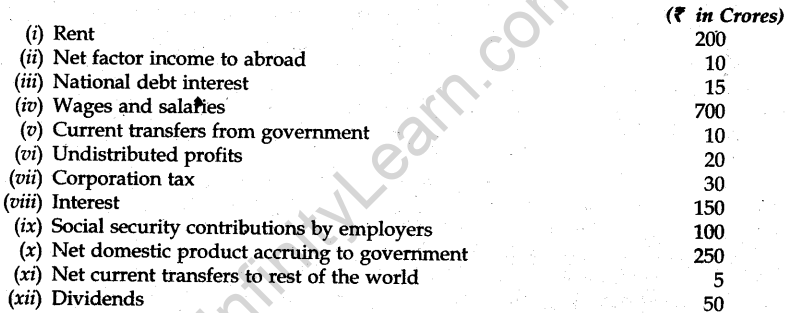
Answer.

SET II
Note: Except for the following questions, all the remaining questions have been asked in Set-1.
SECTION A
Question.2. Define budget line.
Answer. Budget line is a graphical representation of all possible combinations of two goods which can be purchased with given income and prices, such that the cost of each of these combinations is equal to the money income of the consumer.
Question.5. Giving reason comment on the shape of Production Possibilities Curve based on the following schedule:
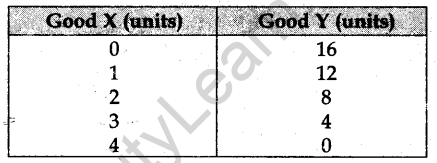
Answer. MRT being constant PPC will be a downward sloping straight line implying that same amount of a commodity is sacrificed to gain an additional unit of another commodity.
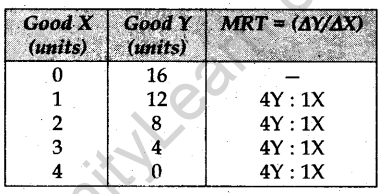
Question.8. Explain the implication of non-price competition in an oligopoly market.
Answer. Non-price competition means competition between firms on the basis of methods other than price. Under oligopoly, firms are in a position to influence the prices. However, they try to avoid price competition for fear of price-war. They follow the policy of price rigidity. Price rigidity refers to a situation in which price tends to stay fixed irrespective of changes in demand supply Conditions. Firms use other methods like advertising, better services to customers etc. to compete with each other.
Question.10. A consumer spends Rs 100 on a good priced at Rs 4 per unit. When its price falls by 25 percent, the consumer spends Rs 75 on the good. Calculate the price elasticity of demand by the Percentage method.
Answer.

Question.11. Market for a good is in equilibrium. The supply of the good “increases”. Explain the chain of effects of this change.
Answer. See Q. 12, 2015 (III Delhi).
SECTION B
Question.21. If the Real GDP is ?500 and Price Index (base = 100) is 125, calculate the Nominal GDP.
Answer.

Question.23. An economy is in equilibrium. Calculate the Marginal Propensity to Save from the following:
National Income = 1000
Autonomous Consumption = 100
Investment = 120
Answer.

Question.29. Calculate “Net National Product at Market Price’ and ‘Personal Income’:
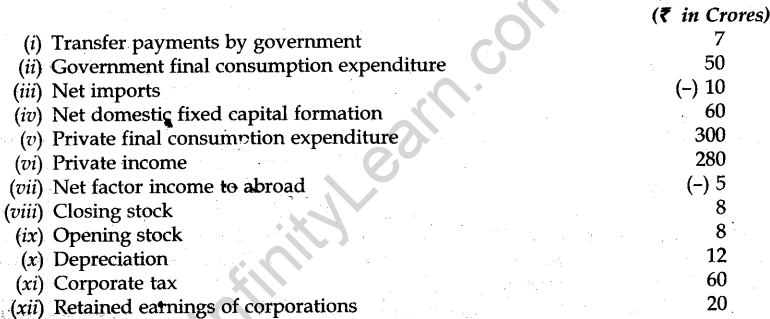
Answer.

SET III
Note: Except for the following questions, all the remaining questions have been asked in Set-l and Set-II.
SECTION A
Question.3. Define Indifference Map.
Answer. Indifference map refers to the family of indifference curves that represent consumer preferences over all the bundles of the two goods.
Question.5. Distinguish between cooperative and non-cooperative oligopoly.
Answer. If the firms co-operate with each other in determining price or output or both, it is called co-operative oligopoly. It is also called as collusive oligopoly.
If firms in an oligopoly market compete with each other, it is called non-cooperative oligopoly. It is also called as non-collusive oligopoly.
Question.8. Giving reason comment on the shape of Production Possibilities Curve based on the following tables
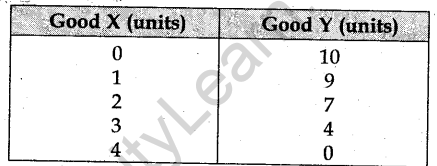
Answer.

Since MRT or the ratio between the units of goods sacrificed (Y) to units of commodity gained (X) is increasing . PPC-will he downward sloping concave to the origin implying that more and more of Y will have to be sacrificed for a unit increase in production of X.
Question.9. A consumer spends Rs 400 on a good priced at Rs 8 per unit. When its price rises by 25 per cent, the consumer spend Rs 500 on the good. Calculate the price elasticity of demand by the Percentage method.
Answer.

Question.12. Market for a good is in equilibrium. Demand for the good “increases”. Explain the chain of effects of this change.
Answer. See Q. 14, 2015 (I Delhi).
SECTION B
Question.22. If the Nominal GDP is Rs 600 and Price Index (base = 100) is 120, calculate the Real GDP.
Answer.

Question.24. An economy is in equilibrium. Calculate the National Income from the following :
Autonomous Consumption = 120
Marginal Propensity to Save = 0.2
Investment Expenditure = 150
Answer.

Question.29. Calculate ‘Net Domestic Product at Market Price’ and ‘Gross National Disposable Income’:
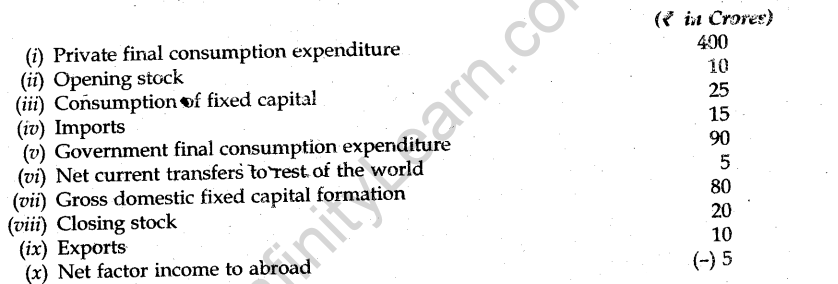
Answer.

EconomicsBusiness StudiesAccountancyMathsEnglish



